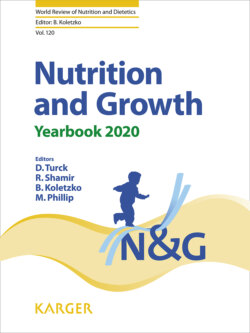Читать книгу Nutrition and Growth - Группа авторов - Страница 35
На сайте Литреса книга снята с продажи.
Bioactive components in human milk are differentially associated with rates of lean and fat mass deposition in infants of mothers with normal versus elevated BMI
ОглавлениеYoung BE1, Levek C2, Reynolds RM3, Rudolph MC4, MacLean P4, Hernandez TL4,5, Friedman JE3,4, Krebs NF1
1Department of Pediatrics, Section of Nutrition, University of Colorado Anschutz Medical Campus, Aurora, CO, USA; 2Department of Pediatrics and Colorado Children’s Hospital Research Institute Biostatistics Core, University of Colorado Anschutz Medical Campus, Aurora, CO, USA; 3Department of Pediatrics, Section of Neonatology, University of Colorado Anschutz Medical Campus, Aurora, CO, USA; 4Department of Medicine, Division of Endocrinology, Metabolism, and Diabetes, University of Colorado Anschutz Medical Campus, Aurora, CO, USA; 5College of Nursing, University of Colorado Anschutz Medical Campus, Aurora, CO, USA
Pediatr Obes 2018;13:598–606
This manuscript is also discussed in Chapter 7 by Larnkjær et al., page 141.
Objective: To model breastfed infant growth and body composition patterns over the first 4 months with multiple bioactive components of human milk (HM) and clinical factors (including maternal BMI status), which are related to growth.
Methods: Longitudinal observation of infant growth and body composition from 0 to 4 months among 41 predominantly breastfed infants (25 mothers of Normal-weight and 16 mothers with overweight/obesity). Fasted morning HM samples were collected at 5 time-points. Macronutrients, leptin, adiponectin, ghrelin, insulin, cytokines and n-6:n-3 esterified fatty acid ratio were measured. Infant weight-for-length Z-score (WLZ) trajectory, fat-free mass (FFM) gain, fat mass gain and %fat gain were modelled controlling for clinical covariates.
Results: HM insulin negatively associated with WLZ trajectory among infants of NW mothers (p = 0.028), but not associated with WLZ trajectory among infants of OW/Ob mothers. HM glucose (p < 0.001) was associated with slower rates of infant FFM gain. Infants of mothers with OW/Ob exhibited slower rates of FFM gain. HM protein, adiponectin and insulin concentrations, and n-6:n-3 ratio were all significant predictors in the model of infant fat mass gain (p < 0.03). Any amount of formula supplementation was associated with faster fat gain (p = 0.002). The model of %fat gain was similar to that of fat mass gain, excepting HM adiponectin was not a significant covariate, and a trend for maternal OW/Ob to correlate with faster %fat gain (p = 0.056).
Conclusions: Bioactive components in HM may contribute to regulation of partitioning of body composition, and these contributions may differ between mothers of normal-weight versus with OW/Ob.
Reprinted with permission from John Wiley & Sons, Inc.
| Comments | This study suggests that specific components present in human milk may contribute differently to the way that breastfed infants partition free-fat mass (FFM) versus fat mass. This effect may differ depending on maternal weight status. Specifically, human milk protein, n-6:n-3 ratio, and insulin may contribute to adiposity, while human milk glucose may contribute to accumulation of lean mass.The study strength is its longitudinal design but is limited by the small sample size. The study data suggest that breastfeeding and human milk may mitigate the risk imposed by in utero exposure to maternal overweight and obesity, strengthening recommendations for exclusive breastfeeding, especially in infants at risk for later obesity. |
______________________
